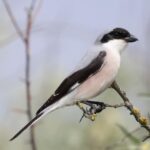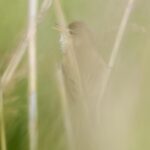Day 1 of another long weekend of tours today and it was off down to the Brecks for the day.
We made a short stop at Lynford first thing. The Hawfinches are not feeding in the Arboretum with any regularity at the moment – there is probably too much food still available for them elsewhere in the forest. However, there are lots of birds starting to sing now and it is always good there early in the morning. As we walked across the road, we could hear a Mistle Thrush singing first, then just a little further along a Song Thrush as well. Coal Tits and Goldcrests were singing from the fir trees.
 Nuthatch – kept coming back to the fat balls
Nuthatch – kept coming back to the fat balls
We stopped by the gate to look at the feeders. A Nuthatch was hanging onto the cage feeder and jabbing furiously at the fat balls in side. It kept coming and going all the time we were there. There were lots of Coal Tits feeding on the piles of seed down on the ground – up to six in view at any one time. The Marsh Tit was harder to see, as it just dropped down briefly, grabbed a seed and made for the cover of the trees.
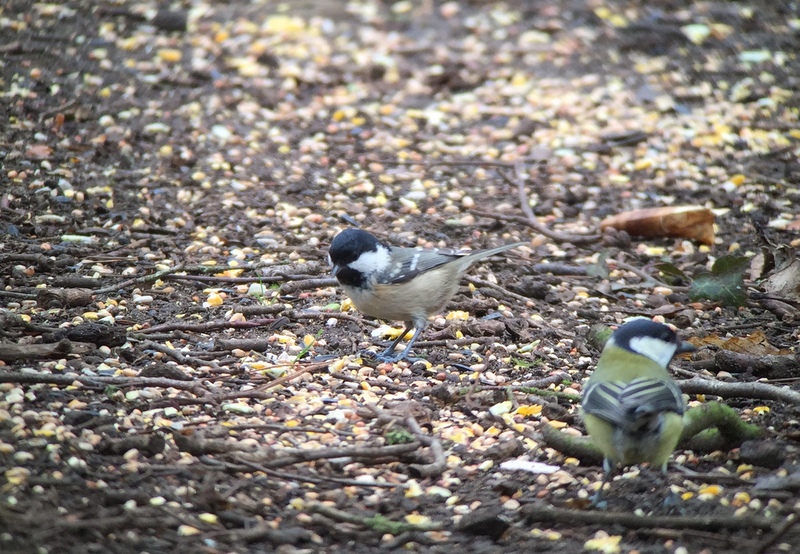 Coal Tit – at least six were down on the ground this morning
Coal Tit – at least six were down on the ground this morning
There were lots of birds coming and going as always here. A flock of Long-tailed Tits flew in to attack the fat balls, and there were lots of Blue Tits and Great Tits too. A few Chaffinches were down in the leaf litter, but predictably there was no sign of any Hawfinches today. We walked on round the Arboretum, but it was a bit cold and quiet deeper in the trees. Several Siskins were zooming around through the treetops, calling. A Goldcrest was singing in the firs, but was very reluctant to come out.
The most pressing target for the morning was Goshawk, so we decided to move on. We drove deeper into the forest and walked down a ride through the pines. When we got to a clearing, we stopped to scan the tops of the trees. Goshawks can spend their whole time deep in the forest without ever emerging. However, at this time of year they are displaying and this is the most reliable time to see them, when the females and males circle higher above the trees to advertise their territory. The best days to look for them are bright and clear, but today was just the opposite – cold and cloudy – not the best weather for hunting for Goshawks. At least it wasn’t raining! We positioned ourselves where we had a good all round vista and waited.
We could hear a mournful song drifting across the clearing and two small birds flew towards us, Woodlarks. One of them landed on a fence post and we got a great look at it through the scope. We could see its clearly marked pale supercilia over the eye and when it turned that they joined in a shallow ‘v’ at the back; its rufous cheek patch; the black and white feathers on the edge of the wing. It sat preening and singing on and off for a while, while the female fed in the grass out in the clearing, before dropping down to join her. Another pair of Woodlarks were circling over the other side.
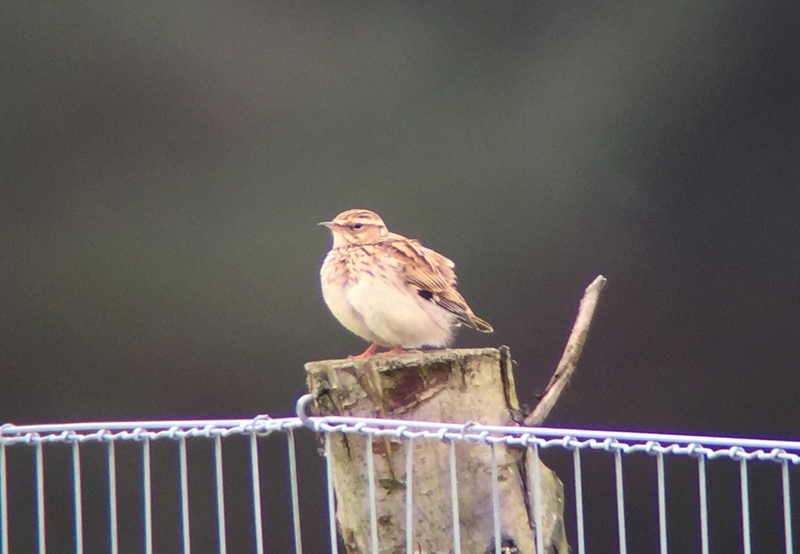 Woodlark – perched on a fence post, preening & singing
Woodlark – perched on a fence post, preening & singing
There were several Skylarks about as well. We could hear them singing and see them fluttering higher into the air. While the Woodlark’s song sounds quite sad, the Skylarks are much more cheerful. As well as getting to compare the song, a Skylark conveniently landed on the path ahead of us, allowing us to note the differences from the Woodlark we had just seen.
Three birds flew towards us over the tops of the pines, calling, a distinctive ‘glip, glip, glip’. They were Crossbills, one of the traditional specialities of the pine forest. Unfortunately they carried on going, overhead and away. Crossbills are an irruptive species, moving around in response to the availability of fir cones and stopping to feed and then breed wherever they find food. They have been in short supply in Thetford Forest in the last couple of years, after the last great invasion in 2013-14, so it was good to see some even if they didn’t stop.
Suddenly, two birds circled up above the trees at the back of the clearing. They were clearly big, alternating grey above and whiter below as they turned. They were two male Goshawks. Conveniently, a roaming male had wandered into a pair’s territory and had provoked them up out of the trees, the resident male setting off after the interloper and trying to see it off. As the two males circled higher, another bird appeared hugging the tops of the trees. Even bigger still, this was the female. She never came up very high above the treetops, content to leave the male to defend the territory, but circled for a short while, before appearing to drop back into the trees.
The two male Goshawks circled together for some time, the interloper appearing to drift off, the resident male peeling off away, before the interloper turned and came back. They came close to each other, one doing a bit of a dive, the other jinking away at the last minute. They did this a few times, even with talons out, almost grappling at one point. Finally, the interloper appeared to get the message and circled away over the trees, and the resident pair melted back into the forest.
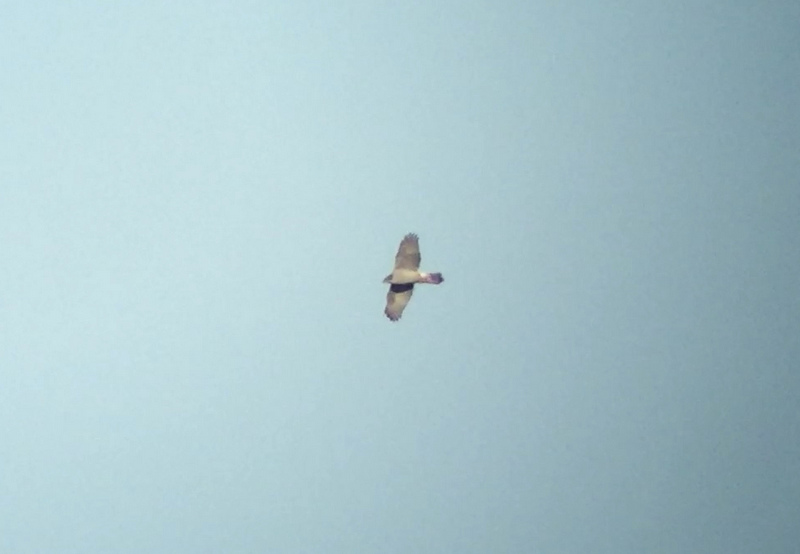 Goshawk – a recent photo of one of the birds
Goshawk – a recent photo of one of the birds
The skies appeared to brighten up a bit to the south, so we waited a while to see if that might bring them up again. A Common Buzzard circled up distantly. But the Goshawks remained in the trees. We decided to move on.
We had hoped to find the Great Grey Shrike which had been spending the winter here (again – it was in the same area last year). It was not seen yesterday in its recently favoured area , around Grime’s Graves, but we thought it was worth a look in case it had come back again today. We drew a blank. We drove round to Santon Downham and stopped for lunch at St Helen’s, but both were quiet – there was no sign of the shrike.
The last possibility was a clearing in the forest which it spent a lot of time in last year. We walked out there to take a look, but there was no sign here either. A Woodlark was singing and a Stonechat perched up on the top of a row of tree stumps briefly. It was increasingly cold and windy, and starting to drizzle, so it seemed unlikely the shrike would be showing itself, even if it was there. We beat a retreat to the car.
With the afternoon getting on, we decided to head back round to Lynford Arboretum to see if we could catch up with the Hawfinches. The drizzle stopped on the way there and it even brightened up a fraction again. There was still no sign of any Hawfinches from the gate – there were a lot more Chaffinches down in the leaves and lots of Woodpigeons. So we continued on down towards the paddocks.
Down by the bridge, a couple had just arrived with carrier bags and were spreading all manner of food around on the posts and tree trunks – seeds, cheese, bread, old crisps. There is often seed spread here and the birds seemed to be anticipating the bounty, they were in the trees and dropping down already. We stopped briefly to admire a Marsh Tit amongst all the other tits.
We had just got over the bridge when we saw a friendly face waving frantically at us from down beside the paddocks. We hurried along to be told that a Hawfinch had just flown in and landed in the trees briefly, before flying across again and dropping down to the ground below out of view. We set up our scopes and waited. A Jay perched in the trees provided a brief distraction.
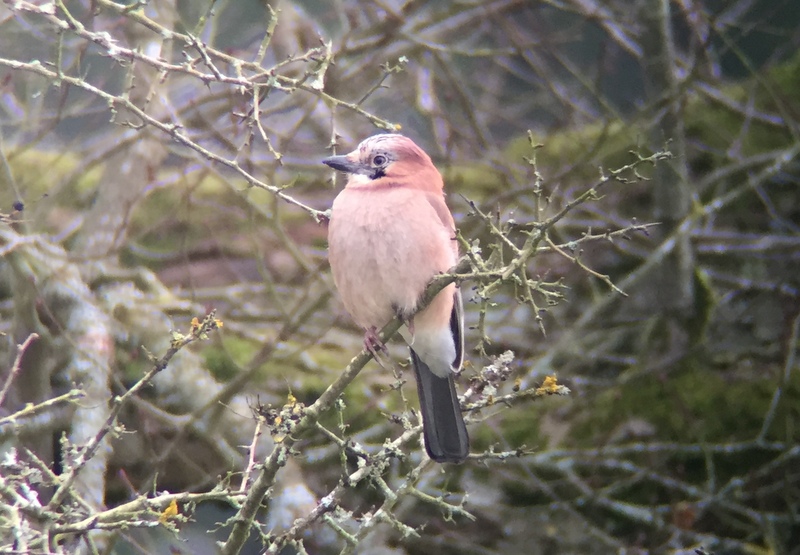 Jay – perched in the paddocks, while we were waiting for the Hawfinch
Jay – perched in the paddocks, while we were waiting for the Hawfinch
There were a few finches zooming back and forth in front of the trees behind and one larger one caught our eye. It landed in the top of a pine tree and a quick look through the scope confirmed that it was a Hawfinch. It was a little distant, but we had enough time to get a good look at it before it dropped down into the pines out of view.
We had not seen the other Hawfinch come up from the ground, so we scanned back over the trees in the middle of the paddock where it had dropped down. Then one of the group gathered on the path shouted that they could see it – in a completely different tree, over to the right, in the exact place where it had first landed earlier. It had sneaked back across there, presumably while we were watching the other Hawfinch in the treetops behind!
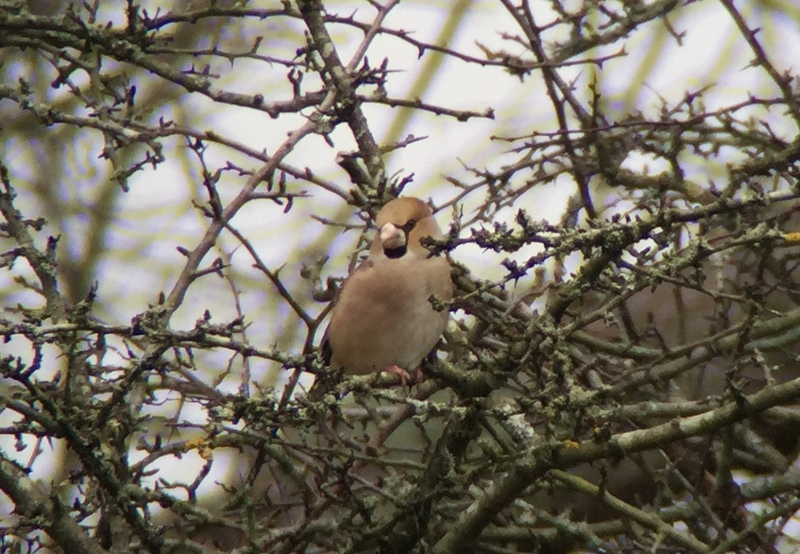 Hawfinch – finally perched nicely in the paddocks for us
Hawfinch – finally perched nicely in the paddocks for us
This was a much better view. We could see the huge bill, with the base outlined in black, extending back in a small mask to the eye and down into a little bib below. When it turned, we could see the grey shawl across the back of the neck. Then it flew further across the paddocks and dropped down again out of view. Great stuff!
With Hawfinch in the bag, we decided to go back to the bridge again to have a closer look at the birds coming down to the food. A Nuthatch was on one of the trees as we approached, probably poking around in the cheese which had been rubbed on the bark. A Treecreeper was working its way up one of the trees by the lake too.
The Long-tailed Tits, Blue Tits and Great Tits were all busy feeding, but the stars of the show were the Marsh Tits. A large block of cheese had been pressed down into the rotten top of one of the wooden posts and they kept flying in to pick at it before zooming out again. With the scopes focused on the post, we got a great look at them. At one point, a Blue Tit attempted to have a go for the cheese as well, and one of the Marsh Tits turned round angrily and stared it down.
 Marsh Tit – feeding on some cheese pressed into the post
Marsh Tit – feeding on some cheese pressed into the post
We walked back to the car park, and continued on to have a quick look at the gravel pits beyond. They were rather quiet today, apart from a few Gadwall and a tight group of Tufted Ducks right over towards the back. Then it was time to call it a day and head for home.
